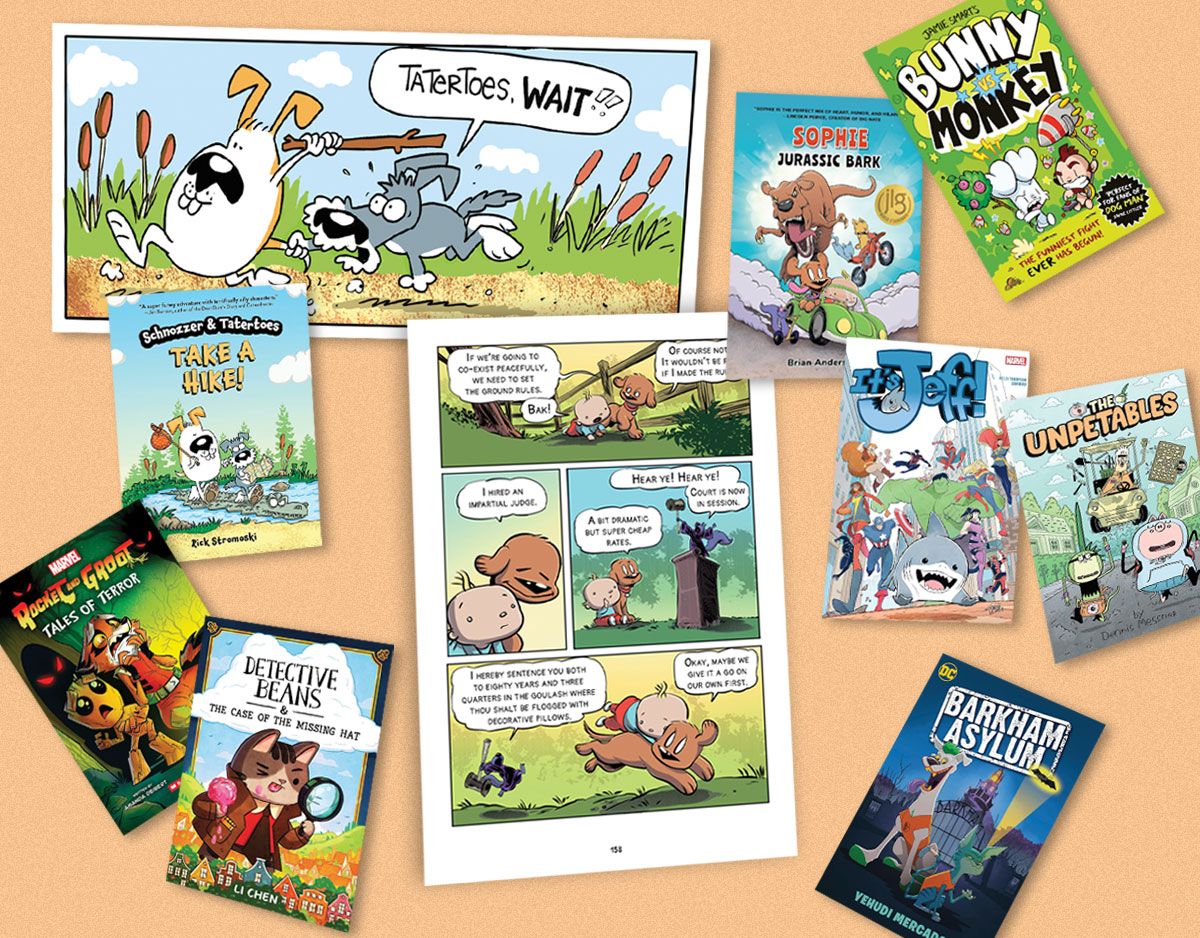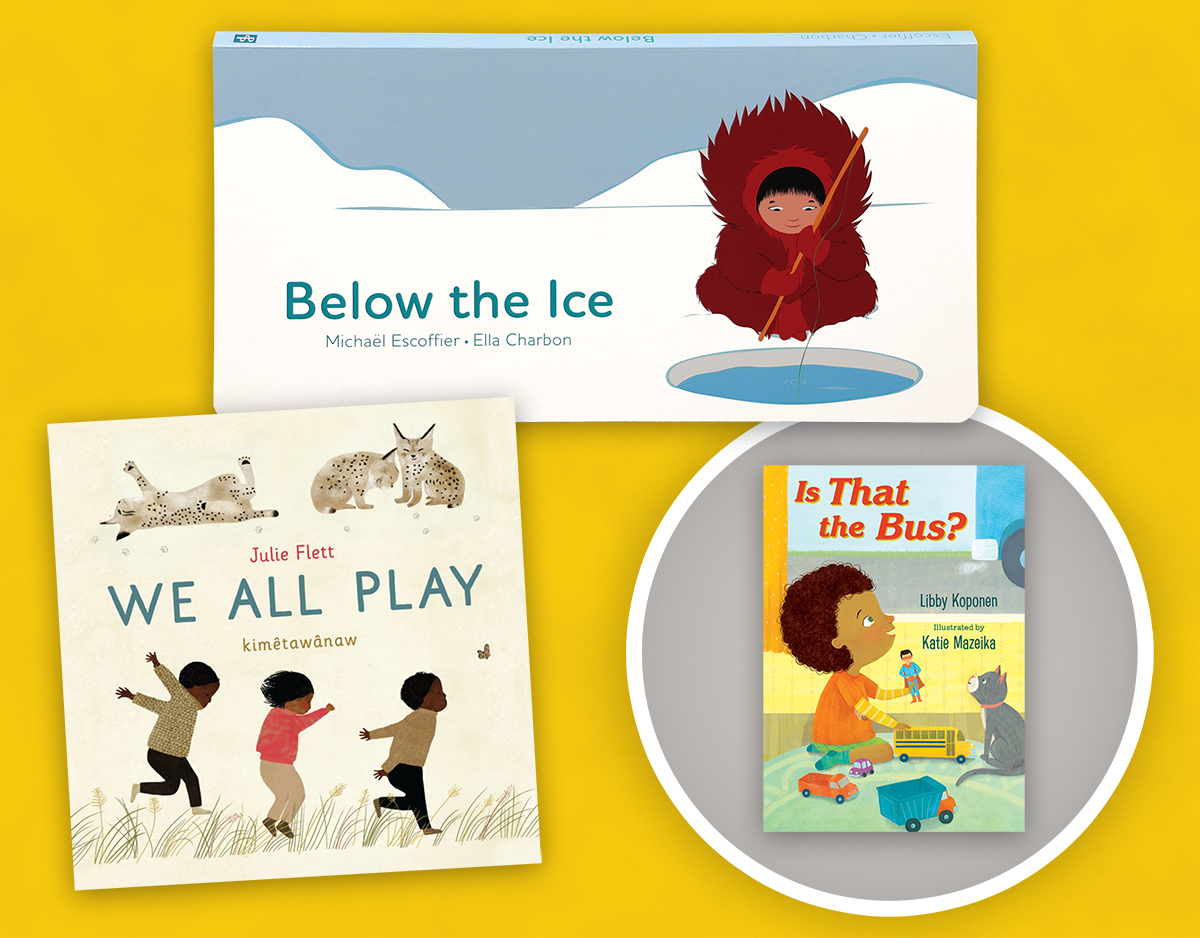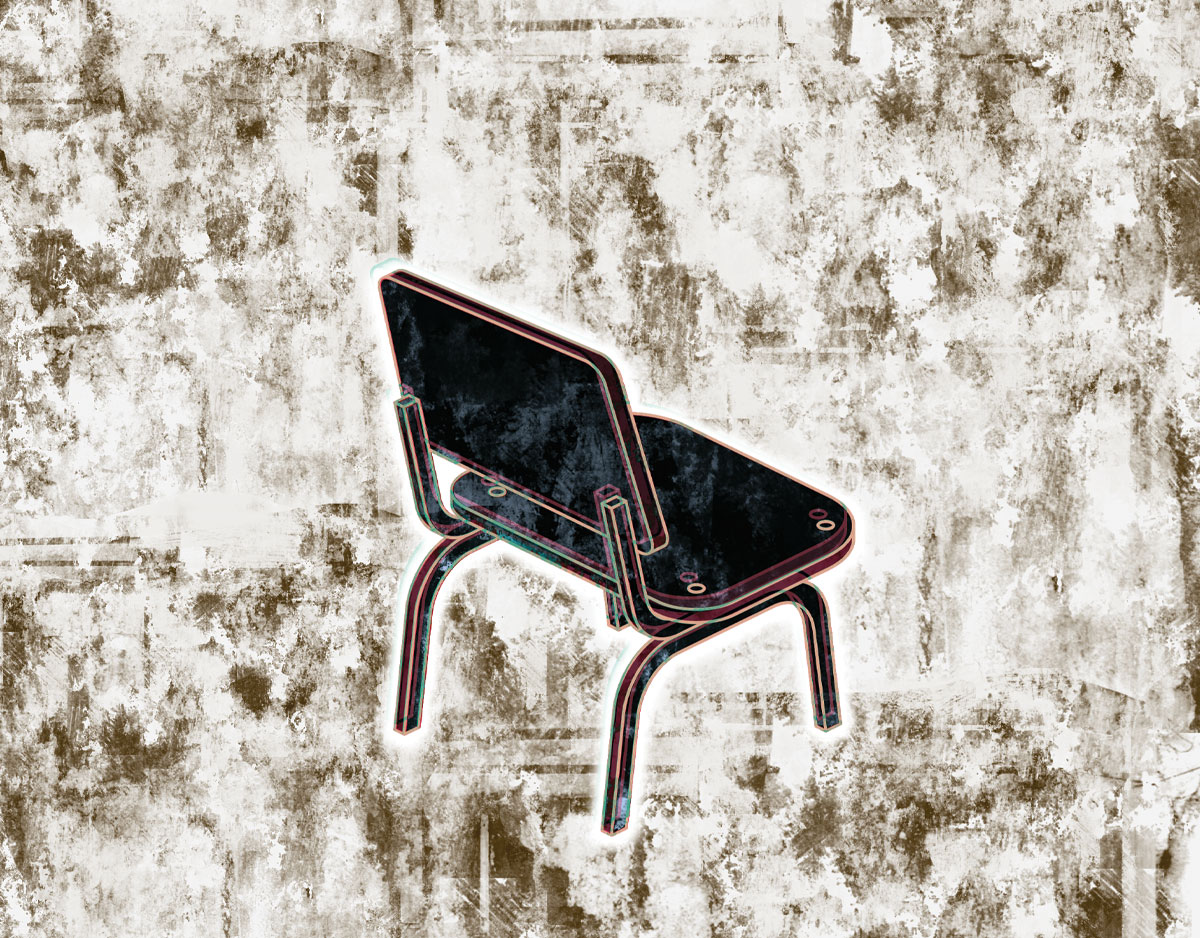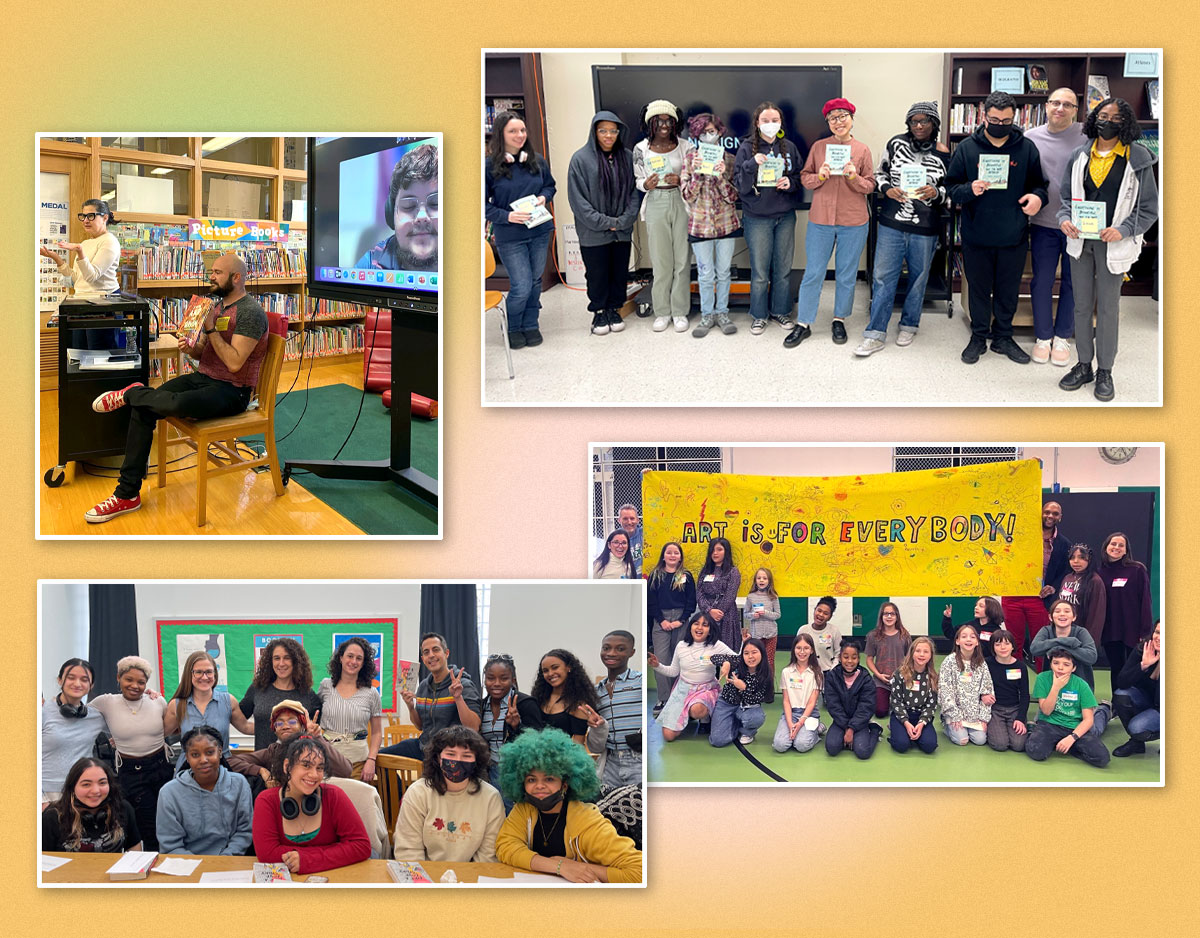Studio Spaces: Art as a Way of Seeing, Feeling, and Sense-Making: Teaching Ideas for the Virtual Exhibit at the Eric Carle Museum

“I believe very strongly that art is a solace, and it is an opportunity for people to forget the world and to relate to the world at the same time. “
— Mo Willems in the introduction to ART in PLACE: Social Distancing in the Studio
The Eric Carle Museum of Picture Book Art, while currently closed due to COVID19, has produced a remarkable virtual exhibition: ART in PLACE: Social Distancing in the Studio. Co-curated by Mo Willems and Ellen Keiter, the online exhibition features picture book artists at work in their studio. This multimodal exhibit affords viewers an intimate view of how these 21 artists have used their creative processes in different ways during the ‘stay-at-home’ phase of the pandemic this spring. Each artist shares a photograph of themself at work in their studio, art that they have created while social distancing, and a narrative about the art and its meaning to them. Viewers can click through the beautifully designed slide show at their own pace, moving forward and backward as they choose. The exhibition also includes an index, so that you can access a particular artist directly. This incredible offering is yet another wonderful example of how, in recent months, the children’s literature community has so generously stepped up to provide rich resources to young people, educators, and families.
ADVERTISEMENT
ADVERTISEMENT
This week’s blog entry provides invitations to take the exhibition experience a step further, using the paintings, prints, and drawings as launch points for art making experiences. You will find general teaching invitations about the exhibition as well as artist-specific invitations organized in two sections below. Viewing the exhibition as a whole and considering each artist’s individual story will inspire students to use visual arts to see their world in new ways; to express their experiences and emotions, and to engage in sense-making during turbulent times.
General Teaching Invitations
Connecting with Illustrations. As you view the illustrations in ART in PLACE: Social Distancing in the Studio invite your students to think and talk about what they are viewing. The Carle Museum espouses the Visual Thinking Strategies developed by Abigail Housen and Philip Yenawine. In this approach students are encouraged to study an illustration closely and to respond to three questions: “What’s going on in this picture? What do you see that makes you say that? What more can we find?” Take your time as you view the illustration created by these picture book artists. Compare and contrast the responses expressed by students. Keep these strategies in mind as you explore the picture books of the artists in this exhibition.
Studying Studio Spaces. Revisit the virtual exhibition a second and third time to study the included photographs of the studios spaces of these illustrators. Talk about what you see – you could even make a list. What kinds of materials are present? How are these materials organized? What do you see on the walls of these spaces – how do these artists center themselves amidst the inspirations and models for their art? What can you learn about how artists work by studying their studio spaces. For your further enjoyment: Mo Willems has been inviting us to draw with him at lunchtime in his studio all spring (Lunch Doodles with Mo Willems!), as has Jarrett J .Krosoczka (Draw Every Day with JJK). Augmenting the view that he has provided in this exhibition, Ryan T. Higgins offers a very humorous video tour of his studio (Studio Time with Ryan T. Higgins – Episode 1).
Setting Up Your Studio. After viewing the studios of these 21 picture book artists, take some time to envision a studio of your own. Remember that to have a studio of your own, you don’t need a lot of space or a set of expensive materials. Think of a studio space as a habit of mind, a practice of drawing in response to experiences. Julie Morstad describes how doodling comforts her and how she is currently seeking to incorporate her spontaneous doodles into more developed pieces. What is your studio like and what will you create? You can find additional inspiration on the Carle museum’s blog Making Art Together and YouTube playlist At Home Art Studio.
Sense-Making Across the Virtual Exhibit. After viewing the exhibition as whole, several times, invite your students to discuss what ideas they are taking away from the experience. Ask them to compare and contrast these artists’ responses to social distancing. Some artists like Peter Sis, David Small, and Michaela Goade have been sustained by gaining long stretches of time to work on current book projects, others, like Katie Harnett have used the time for new challenges (Katie is “drawing from life” instead of her preferred activity of drawing imaginary worlds), and some are working on themed projects (Beatrice Alemagna is creating portraits of artists). Some, like Marla Frazee, are finding new ways to make the world a more beautiful place (Marla is planting nasturtium seeds everywhere, like Miss Rumphius and her lupines – please post photos when they bloom, Marla!). Next ask students what they have learned about the artistic process from these artists? How have these artists helped them to see themselves as artists, too?
About the Illustrator. This wonderful exhibition can inspire a more in depth exploration of the work of each of these picture book artists. The exhibition includes links to their websites (also included throughout this entry) which is a wonderful starting point for an exploration of each artist. You can also search YouTube to find video interviews. Use the online platforms for e-book access that we have shared in recent entries or draw upon the resources in your local library systems (as they reopen with social distancing measures in place) and read several books created by the illustrator. Invite students to share what they are noticing about the author’s artistic style, preferred medium, and their values and commitments as expressed by their illustrations. Invite your students to emulate the artistic style of the illustrator by creating original images that incorporate the elements they have noted. To learn more about the process of illustrating picture books, you may want to explore Picture This by illustrator Molly Bang, followed by a discussion of her theory of illustration written by A. Walter Hastings.
Critical Literacy
Art as Activism. During the past several weeks, social distancing has been overridden by the imperative to protest systemic racism and police brutality. The children’s literature community held a virtual rally KidLit Rally 4 Black Lives hosted by The Brown Bookshelf and organized by Kwame Alexander, Jacqueline Woodson, and Jason Reynolds. In this video, Jason Reynolds urges young people to use the power of their voice to communicate their experiences and to advocate for change. Discuss how art can be activism in a variety of forms. Children’s book illustrators in this exhibit use their art to further our understanding of history, culture, and life stories. Vashti Harrison uses art to tell the life stories of key figures in African American History, such as Little Leaders: Bold Women in Black History ; Michaela Goade illustrator of We Are Water Protectors vividly depicts environmental justice activism at the Standing Rock Sioux Reservation; Ashley Bryan has been sharing African American stories and songs for decades (also see his acclaimed work of historical fiction Freedom Over Me: Eleven Slaves, Their Lives and Dreams Brought to Life); and Melissa Sweet has illustrated a A Splash of Red: The Life and Art of Horace Pippin, a picture book biography of a self-taught African American artist, authored by Jen Bryant. Creating these stories are acts of advocacy and as you conduct illustrator studies for each of the showcased artists (see the teaching invitation above), you will find many additional examples of how these artists have used their creativity to advocate for a better, more just world. Explore additional ways that art can be activism by reading books such as Javaka Steptoe’s Radiant Child: The Story of Young Artist Jean-Michel Basquiat, and Isabel Campoy’s Maybe Something Beautiful, Duncan Tonatiuh’s Diego Rivera, His World and Ours,
Artist-Inspired Teaching Invitations
Beatrice Alemagna: Art Inspired by Art. Beatrice Alemagna has been using found time during social distancing to pursue a personal project – painting a series of portraits of famous artists. She shares two of these portraits in the exhibition. Learn more about Yayoi Kusama in Sarah Suzuki and Ellen Weinstein’s picture book biography Yayoi Kusama: From Here to Infinity! and more about Edvard Munch at the Munch Museum in Norway. Engage your students in a discussion of how art can inspire art and offer them a choice for how they might experience this for themselves. Students could, like Beatrice Alemagna, select an artist who intrigues them, learn more about that artist, and create a portrait of the artist. Alternatively, students could select a favorite work of art and create art that pays tribute to their selection. Ask students to create display cards for their artwork and compile their work in a digital exhibition. For more teaching invitations about Art Inspired by Art, see our Classroom Bookshelf Entry: World Make Way: New Poems Inspired by Art from The Metropolitan Museum of Art
Sandra Boynton: Stop Motion Animation. The imaginative musical video created by Yo-Yo Ma and Sandra Boynton is a clear call for students to make their own animated music video. Collaborate with your technology specialist or school library media specialist to introduce students to a tool such as Stop Motion Studio. Students can use a favorite music selection (consider Educational Fair Use Policy) or compose their own soundtrack. What visual images are invoked by the music? Invite students to create and coordinate a series of images to accompany the musical selection. You and your students may also enjoy reading Barbara Rosenstock and Mary Grandpré’s picture book biography The Noisy Paint Box: The Colors and Sounds of Kandinsky’s Abstract Art.
Ashley Bryan: Looking Closely. Ashley Bryan describes how his niece helped him to create a studio away from home by setting him up with paints and pots of flowers on her porch. Ashley Bryan’s painting of these flowers is an invitation to look closely, to see the beauty and detail in our surroundings. Invite your students to look closely inside and outside of their home or, if possible, while on a walk through their community. Ask them to select something they see that is beautiful to them. WIth the goal of creating art that depicts their selection, invite them either to jump right into art making or you could choose to begin by discussing and/or listing what they see when looking closely – what are the colors, shapes, textures, lines that they will emphasize in their artwork?
Raúl Colón: Symbolism in Art. Use the Visual Thinking Strategies (see the first Teaching Invitation above) to discuss Raúl Colón’s Love in a Time of Fear. Next, read the MET’s overview of Symbolism in the Heilbrunn Timeline of Art History. Ask students to consider the symbolism in Colón’s work. What meaning do they draw from this image? Invite students to use symbolism to represent their experiences during the pandemic. What images symbolically represent their actions, emotions, and social experiences during this time period?
Elisha Cooper: Travel by Pencil and Brush. Using the vehicle of graphite and watercolor, Elisha Cooper has been traveling during the pandemic. The artist has been keeping himself busy by painting places that he would like to visit: “I’ve been painting myself away to other places.” Invite your students to list places that they would like to go. Next, ask students to find photographs of these places. Notice together how Elisha Cooper uses line and color to create his images. As students study the photographs of the places they have selected, guide them to notice line and color in the photographs and encourage them to emulate Cooper’s style as they create their own drawings and paintings. Compile your students’ images to create a virtual tour of their wish list of travel sites.
Carson Ellis: Emotion, Color, and Perspective. Carson Ellis’s illustrations offer an opportunity to explore the ways that color and perspective can create an emotional experience. After viewing and discussing her painting Only Children, Hang Tight, invite your students to think about an image or a message that has been on their minds during the lockdown period and to create a work of art to convey this using only one color. Carson Ellis also highlights perspective in her narrative, noting about the time period: “It feels dreamy, like we’re all underwater seeing the world through a new, strange, swimmy lens.” Share Brendan Wenzel’s innovative picture book They All Saw a Cat to prompt a discussion of how the images students have created reflect their perspective on social distancing.
Vashti Harrison: Escape. When faced with the enormity of our current societal challenges, it’s natural to long for escape, refuge, and comfort. Ask your students to talk about the people, activities, and settings in their lives who/which support them to gain respite from stress, worry, and fear. Invite your students to create an image that depicts their “escape” as Vashti Harrison has done. Share these images with one another and compare and contrast each other’s preferences. Consider creating a class book using a platform such as Google Slides exported as a .pdf or Book Creator.
Will Hillenbrand: Self Portrait. Will HIllenbrand has created a portrait of himself as he would appear on a video conference call. An image that many of us are finding far too familiar these days. Invite your students to create a self portrait that reflects who they are at this time. Students could start by taking a selfie, but encourage them to move beyond this format, experimenting with different artistic media. Expand students’ possibilities by viewing the virtual exhibition National Portrait Gallery: Eye to I: Self-Portraits from 1900 – Today. Extend your exploration of self portrait with an exploration of autobiography using titles such as Ashley Bryan’s Words to My Life’s Song, Lois Ehlert’s The Scraps Book: Notes From a Colorful Life, Allen Say’s Drawing From Memory, and Yuyi Morale’s Dreamers.
Hadley Hooper and Amber Ren: A Museum of Memories. Both Hadley Hooper and Amber Ren describe how they are exploring memories during this time period. Hadley describes how, during this time period while museums are closed, she has been creating her own by painting memories of objects and travel that have been significant to her. Invite your students to create a museum of memories, either individually or collectively (or both). Discuss the concept of a museum, museums that students have been to, and what they know about how museums might be structured (for more on virtual Museum access see our Classroom Bookshelf entry Using Online Museum Resources for Literacy Learning). Students can share their museum using Google Slides, Padlet, Jamboard or Flip Grid.
LeUyen Pham: Outside, Inside, Outside. The illustrations created by LeUyen Pham dramatically depict the changes in our communities brought on by social distancing. Many striking photographs have been taken to document cities in lockdown. These images of empty streets were then followed by images of streets filled with protestors for the Black Lives Matter Movement. Invite your students to follow LeUyen Pham’s example, creating before, during, and ongoing images of their communities during the pandemic and the protests.
Dan Santat: Homemade Instruments. After viewing Dan Santat’s marvelous ukulele, invite your students to use recycled materials to create an instrument of their own (an online search for homemade instruments turns up a myriad of possibilities). Students can share images of their instruments and record the sounds they make using Flip Grid. If you are especially tech savvy or know someone who is, you might even consider coordinating a composition for which each student records a track that can be compiled into a whole. For more inspiration see Susan Hood’s Ada’s Violin: The Recycled Orchestra of Paraguay and Troy Andrews’s Trombone Shorty.
ADVERTISEMENT
ADVERTISEMENT
Melissa Sweet. Picture Book Biographies of Artists. Melissa Sweet shares images from a forthcoming picture book biography of artist Judith Scott. Engage in a genre study that focuses on picture book biographies of artists (the listing in this Classroom Bookshelf entry for Between the Lines: How Ernie Barnes Went from the Football Field to the Art Gallery will get you started). Be sure to select a diverse representations of artists and artistic styles. Read the books with your students and closely examine the choices that the biographers (authors and illustrators) have made about text and illustration. Which aspects of their subjects’ lives have they chosen to highlight? Do they focus more on the childhood or adult life of the artist? How are the artists’ mentors, inspirations, commitments, and styles presented? When examining the illustrations, discuss how the art of the picture book biography enhances the reader’s’ understandings of the artists’ lives and work. Notice how the artists’ works are depicted in the book. Are they reproductions of the actual works or are they illustrators’ representations?( To learn more about how Melissa Sweet supported a third grade study of picture book biographies, read this article co-authored by Melissa, Erika, Mary Ann, Jen Bryant and Lorraine Magee). After reading a range of life stories about artists, ask students to respond personally to the question posed by Melissa Sweet: “‘What would I do next as an artist if it was for the pure joy of making?”
Mo Willems: Abstract art. Mo Willems, in addition to creating daily opportunities for young people to make art alongside him in his studio, has been creating Abstract Art. Learn more about this form at the Tate Museum and revisit this quote from Mo Willems narrative in the exhibition: “All the ingredients that make up abstractions (form, color, experiments, mistakes, inspiration) are fundamental and they persevere. Much as we must.” What meaning do students make from this quote? Invite your students to create and share their own works of abstract art. Learn more about Abstract art by reading these picture book biographies: Jan Greenberg, Sandra Jordan, and Robert Andrew Parker’s Action Jackson (a life story of Jackson Pollock), Barbara Rosenstock and Mary Grandpré’s The Noisy Paint Box: The Colors and Sounds of Kandinsky’s Abstract Art, Marjorie Blain Parker and Holly Berry’s Colorful Dreamer: The Story of Artist Henri Matisse, and Amy Novesky and Yuyi Morales’s Georgia in Hawaii: When Georgia O’Keeffe Painted What She Pleased.
Further Explorations
Online Resources
The Eric Carle Museum of Picture Book Art
The Eric Carle Museum of Picture Book Art: Making Art Together
Reading Together: Books as a Site for Connection and Comfort
Using Online Museum Resources for Literacy Learning
Common Sense Media: Websites and Apps for Making Videos and Animation
National Portrait Gallery: Eye to I: Self-Portraits from 1900 – Today
MET’s overview of Symbolism in the Heilbrunn Timeline of Art History.
BBC News: Photos Show Deserted Lockdown Locations at High Noon
The Atlantic: Images From a Worldwide Protest Movement
This Classroom Bookshelf entry includes links to a wide range of picture book biographies that we have featured on the blog: Sandra Neil Wallace and Bryan Collier’s Between the Lines: How Ernie Barnes Went from the Football Field to the Art Gallery
Books
Andrews, T. (2015). Trombone Shorty. Ill. by B. Collier. New York: Abrams Books.
Bang, M. (2016). Picture this. Chronicle Books.
Bryan, A, (2016). Freedom over me: Eleven slaves, their lives and dreams brought to life. New York: Atheneum.
Bryan, A. (2009). Ashley Bryan: Words to my life’s song. Ill. by B. Meguinnes. New York: Atheneum.
Bryant, J. (2013). A splash of red: The life and art of Horace Pippin. Ill. by Melissa Sweet. New York: Alfred A. Knopf.
Cooney, B. (1982). Miss Rumphius. Ill. by B Cooney. New York: Viking Press.
Ehlert, L. (2014). The scraps book: Notes from a colorful life. New York: Beach Lane Books.
Harrison, V. (2017). Little leaders: Bold women in black history. New York: Little Brown.
Hood, S. (2016). Ada’s violin: The recycled orchestra of Paraguay. Ill. by S.W. Comport. New York: Simon & Schuster.
Lindstrom, C. (2020). We are Water Protectors. Ill. by M. Goade. Roaring Book Press.
Morales, Y. (2018). Dreamers. New York: Neal Porter.
Rosenstock, B. (2014). The noisy paint box: The colors and sounds of Kandinsky’s Abstract Art. Ill. by M. Grandpré. New York: Knopf.
Tonatiuh, D. (2011). Diego Rivera: His world and ours. New York, NY: Harry N. Abrams.
Wenzel, B. (2016). They all saw a cat. San Francisco, CA: Chronicle Books.
Filed under: Announcements, Classroom & Curricular Ideas, Picture Books
About Erika Thulin Dawes
Erika is a professor of language and literacy at Lesley University. A former classroom teacher, reading specialist, and literacy supervisor, she now teaches courses in children’s literature, early literacy, and literacy methods. Erika is the co-author of Learning to Write with Purpose, Teaching with Text Sets, and Teaching to Complexity.
ADVERTISEMENT
ADVERTISEMENT
SLJ Blog Network
One Star Review, Guess Who? (#215)
A Pumphrey Brothers Cover Reveal! Conversation and a Peek at The Old Sleigh
Investigators Agents of S.U.I.T. Wild Ghost Chase| Review
Fifteen early Mock Newbery 2026 Contenders
When Book Bans are a Form of Discrimination, What is the Path to Justice?
Take Five: Middle Grade Books on Women’s History
ADVERTISEMENT







